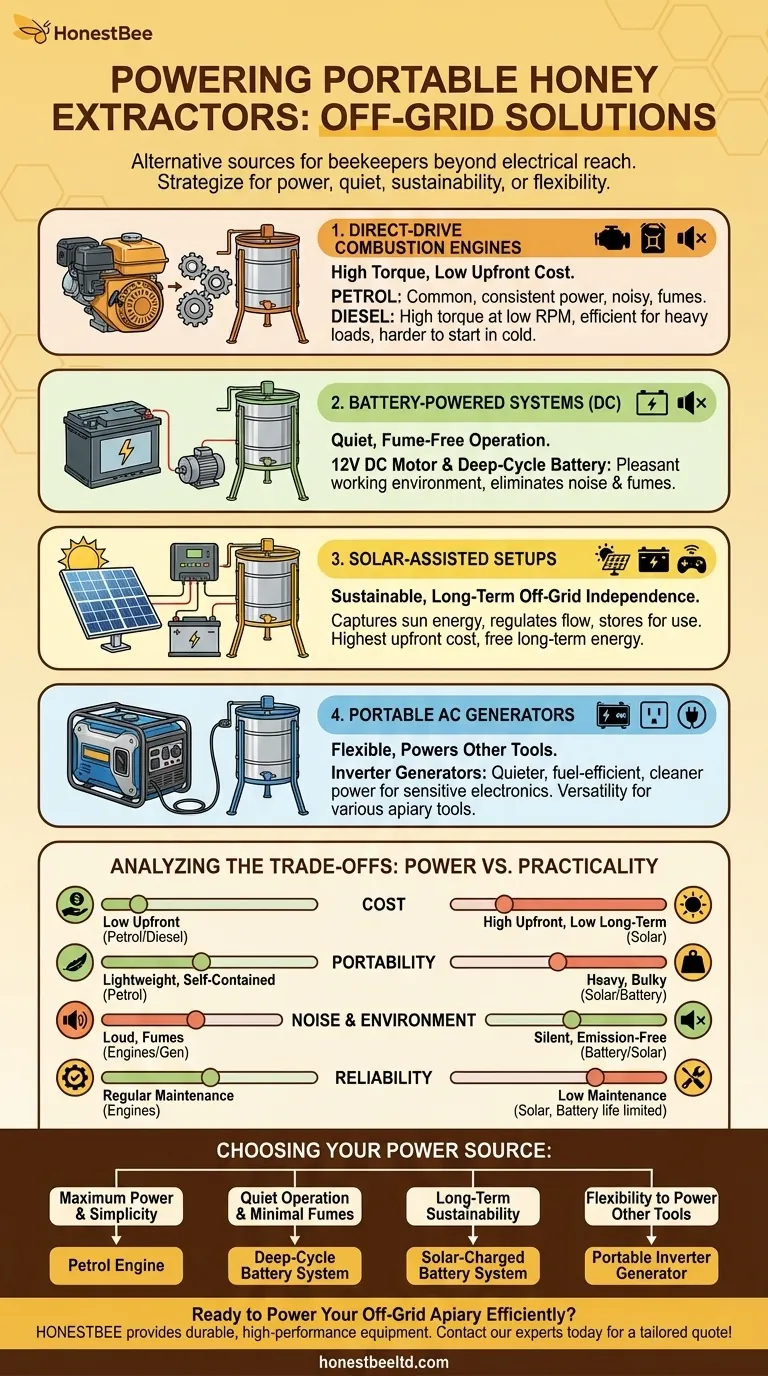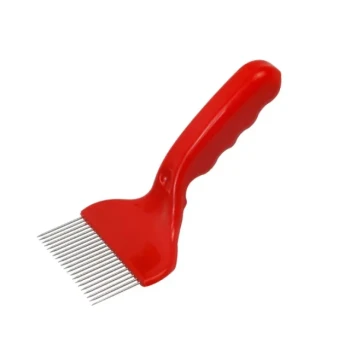For beekeepers operating beyond the reach of an electrical outlet, the choice of power for a portable honey extractor is critical. The primary alternatives to standard electricity are direct-drive combustion engines (petrol or diesel), battery-powered DC systems, solar-recharged battery setups, and portable AC generators. Each solution offers a distinct balance of power, portability, cost, and convenience for working in the field.
Your choice of an alternative power source is not just a technical decision; it's a strategic one. The "best" option depends entirely on whether your priority is raw power, quiet operation, long-term sustainability, or overall flexibility.

Understanding Your Power Options
Choosing how to power your extractor in a remote apiary involves more than just finding a motor. You are essentially designing a small, mobile power station. The main approaches fall into a few key categories.
Direct-Drive Combustion Engines
This is the traditional method for high-torque, off-grid power. The engine is coupled directly to the extractor's drive mechanism.
- Petrol Engines: These are common, relatively lightweight, and easy to start and maintain. They provide consistent power but produce significant noise and exhaust fumes.
- Diesel Engines: As noted in some specifications, diesel engines operate at lower RPMs with higher torque, which can be beneficial for spinning heavy, full frames. However, they are typically more expensive and can be difficult to start in cold weather as the fuel thickens.
Battery-Powered Systems (DC Power)
This is an increasingly popular solution known for its quiet and clean operation.
An extractor equipped with a 12-volt DC motor is connected directly to a deep-cycle battery, similar to those used in boats or RVs. This setup eliminates the noise and fumes of a combustion engine, creating a much more pleasant working environment for both the beekeeper and the bees.
Solar-Assisted Setups
A solar setup is not a direct power source but rather a method for recharging your battery system. It represents the ultimate in off-grid self-sufficiency.
The system consists of three main parts:
- Solar Panels: To capture energy from the sun.
- A Charge Controller: To regulate the flow of electricity and protect the battery.
- A Battery Bank: To store the power for use at any time, even on cloudy days.
While it has the highest upfront cost, a solar-assisted system provides free, silent, and clean energy for the long term.
Portable AC Generators
A portable generator does not drive the extractor directly. Instead, it creates standard AC electricity (like a wall outlet), allowing you to run a standard electric extractor anywhere.
Modern inverter generators are a superior choice. They are significantly quieter, more fuel-efficient, and produce "cleaner" power that is safer for sensitive electronic motor controls. This offers the flexibility to power other tools at your apiary as well.
Analyzing the Trade-offs: Power vs. Practicality
There is no single perfect solution. Your decision must be based on a clear understanding of the compromises involved with each power source.
Cost: Upfront vs. Long-Term
A petrol engine has a low initial cost but requires ongoing fuel expenses. A full solar-assisted battery system has the highest upfront investment but costs virtually nothing to run. A simple battery system sits in the middle but requires eventual battery replacement.
Portability and Weight
A small petrol engine is relatively self-contained and portable. A battery system adds significant weight, and a solar setup adds both weight and bulk with panels that must be transported and positioned.
Noise and Environmental Impact
This is a major dividing line. Combustion engines and most generators are loud and produce fumes, which can be disruptive. Battery and solar systems are completely silent and emission-free, preserving the tranquility of a remote apiary.
Reliability and Maintenance
Engines require regular maintenance like oil changes and spark plug replacements. Batteries have a finite lifespan of several years. A solar charging system is very low-maintenance but is dependent on available sunlight to recharge your system.
Choosing the Right Power Source for Your Apiary
To make a final decision, evaluate your most common working conditions and personal priorities.
- If your primary focus is maximum power and simplicity: A direct-drive petrol engine is the most straightforward and cost-effective choice for raw spinning power.
- If your primary focus is quiet operation and minimal fumes: A deep-cycle battery system is the ideal solution for a peaceful and clean extraction process.
- If your primary focus is long-term sustainability and off-grid independence: A solar-charged battery system is the ultimate goal, despite the higher initial investment.
- If your primary focus is flexibility to power other tools: A portable inverter generator provides the versatility of standard AC power for your extractor and more.
Ultimately, equipping your apiary with the right power source empowers you to work efficiently and in harmony with your environment.
Summary Table:
| Power Source | Key Features | Best For |
|---|---|---|
| Petrol/Diesel Engine | High torque, low upfront cost | Maximum power, simplicity |
| Battery System (DC) | Quiet, fume-free operation | Minimal noise and disruption |
| Solar-Assisted Setup | Sustainable, long-term off-grid use | Energy independence |
| Portable Generator (AC) | Flexible, powers other tools | Versatility at the apiary |
Ready to Power Your Off-Grid Apiary Efficiently?
As a trusted supplier for commercial apiaries and beekeeping equipment distributors, HONESTBEE provides the durable, high-performance equipment you need. We can help you select the right extractor and power solution to maximize your harvest, whether you prioritize quiet operation, raw power, or total energy independence.
Contact our wholesale experts today to discuss your specific needs and get a quote tailored to your operation.
Visual Guide

Related Products
- Plastic Hand Crank 2 Frame Honey Extractor Low Price
- HONESTBEE 3-Frame Manual Acrylic Honey Extractor
- 6 Frame Manual Stainless Steel Honey Extractor Beekeeping Equipment
- Stainless Steel 3 Frame Manual Honey Extractor Spinner for Bee Honey Extraction
- Commercial Electric 12 Frame Honey Extractor Spinner Motorized Honey Extractor
People Also Ask
- Can honey be harvested from frames with brood? The Critical Rule for Healthy Bees & Pure Honey
- What are the advantages of manual honey extractors? Ideal for Hobbyist & Small-Scale Beekeepers
- What is the cut and strain method of honey extraction? A Simple, Low-Cost Approach for Hobbyists
- What equipment is used for honey harvesting? Build Your Perfect Harvesting Toolkit
- How do you extract honey by hand? A Guide to Crush & Strain vs. Manual Extractor



















